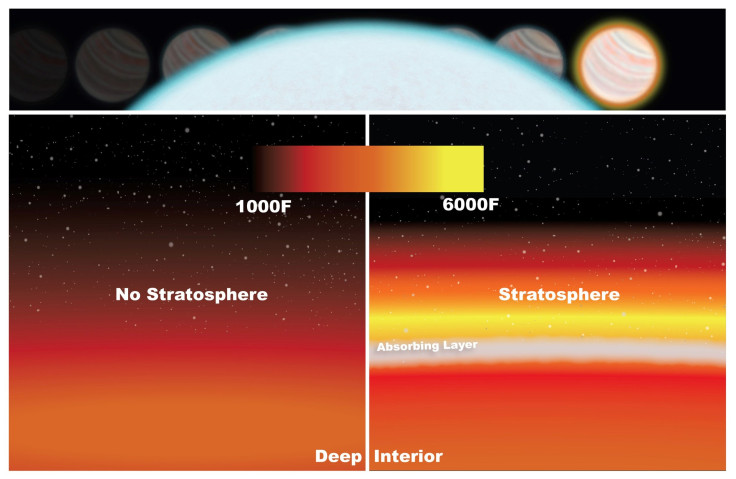'Sunscreen' Layer Of Stratosphere Discovered Around 'Blazing-Hot' Exoplanet

Using NASA’s Hubble Space Telescope, scientists have detected the presence of a stratosphere -- one of the many layers that make up Earth’s atmosphere -- on a planet named WASP-33b, which, at a temperature of nearly 5,800 degrees Fahrenheit, is the hottest known planet in the universe. The discovery of this atmospheric layer, which acts as “sunscreen” for the planet it surrounds, can provide vital clues about planetary formation and evolution.
Until now, researchers were not sure whether the molecules that compose the stratosphere could exist in the atmospheres of massive, hot planets in other solar systems.
“Some of these planets are so hot in their upper atmospheres, they’re essentially boiling off into space,” Avi Mandell, a planetary scientist at NASA’s Goddard Space Flight Center in Greenbelt, Maryland, and a co-author of the study detailing the findings, said in a statement released Thursday. “At these temperatures, we don’t necessarily expect to find an atmosphere that has molecules that can lead to these multilayered structures.”
On Earth, for instance, the stratosphere -- extending between 10 to 31 miles from the surface -- is located just above the troposphere. This layer has the highest concentration of ozone that absorbs much of the sun’s damaging ultraviolet radiation, preventing it from reaching the surface and allowing life to exist.
On Earth as well as on other planets in our solar system such as Jupiter and Saturn, the stratosphere exhibits “temperature inversion” -- wherein the temperature increases with altitude. This is in contrast to the troposphere -- which extends up to 10 miles above the Earth’s surface -- where it’s warmer at the bottom.
Temperature inversion in Earth’s stratosphere occurs because of the presence of ozone, while on Jupiter and Saturn, it is caused by the presence of hydrocarbons. However, scientists believe that these molecules cannot survive at the high temperatures of most known exoplanets, much less in the atmosphere of WASP-33b.
Scientists now believe that the observed temperature inversion in the atmosphere of WASP-33b, which has about four-and-a-half times the mass of Jupiter, is caused by titanium oxide -- one of the few compounds that are strong absorbers of visible and ultraviolet radiation and capable of remaining in gaseous form in an atmosphere as hot as that of WASP-33b.
“Understanding the links between stratospheres and chemical compositions is critical to studying atmospheric processes in exoplanets,” co-author Nikku Madhusudhan from the University of Cambridge, said in the statement. “Our finding marks a key breakthrough in this direction.”
© Copyright IBTimes 2024. All rights reserved.





















